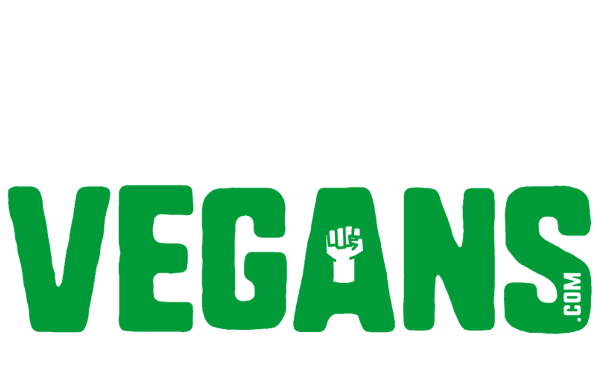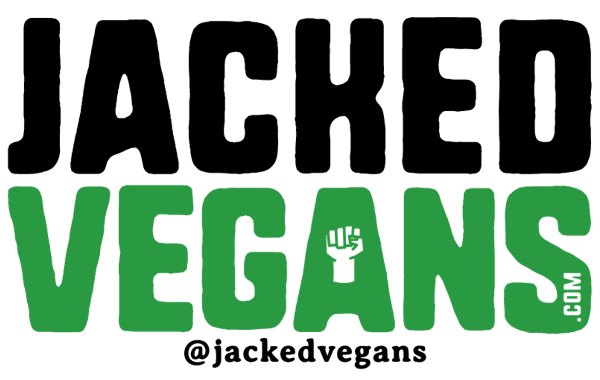So you’ve decided to go all-in and transition to veganism?
First, I’d like to congratulate you for taking a massive step towards reducing animal cruelty and your environmental impact on the Earth. This is a life-changing decision, and I imagine you’re going through all sorts of emotions right now; excitement, apprehension, and maybe even confusion.
It can be challenging to make the change if you’re unsure how to do it, but we have you covered. Today, we’ll talk about how you can make the transition as smooth as possible and ensure you’re better prepared to handle the unique challenges that come with a vegan lifestyle.
Let’s dive in.
How do you start to become a vegan?
What is your motivation for turning vegan?
It is easy to get sidetracked from a vegan lifestyle if you don’t have strong enough motivation, especially if you love a particular food. Some people find it challenging to switch due to their attachment to certain foods derived from animals.
Let’s take cheese, for example. For some, removing cheese from their diet is enough reason to stop them from switching to a vegan lifestyle. They sit on the decision for months, procrastinating and weighing whether switching to a vegan lifestyle is worth cutting out cheese. One month turns into two, three, four months, then into a year, and they still haven’t switched.
Then there are others whose craving for cheese is enough to reel them back into consuming animal products.
Whether that’s the case or not, it’s important to remember why you are doing this.
Perhaps it was the time you visited the slaughterhouse and saw firsthand how they butchered animals for their meat.
Maybe you consider yourself an animal lover and cannot accept that you’re using their products and, in a sense, paying someone to make more animals suffer.
Or maybe the video showing the horrendous living conditions cows have to endure to provide milk deeply affected you. What about helping mitigate climate change?
A good motivation goes a long way in keeping you on track and your values clear.
Educate yourself before making the transition
Whether you take the lengthy approach or quit animal products cold turkey, you will want to educate yourself before making the switch.
Going back to cheese, if it’s the one thing preventing you from transitioning to veganism, perhaps you would like to watch more videos or documentaries and read more blog posts like this from PETA that detail how cheese is made.
You’ll gain valuable insight into food production that will help support your decision to go vegan.
One other way to educate yourself is to learn about the dietary needs associated with a vegan diet. Plant-based eating can put you at risk of missing out on essential vitamins and minerals that your body needs to function optimally. You might need to work with a dietician or other professionals (apply to become a Jacked Vegan ) to ensure that you’re getting all the nutrients you need in your diet.
It’s also hard to let go of your favorite foods like burgers, cheese, and milk. You will crave these foods at some point, so you want to research the best alternatives to replace them.
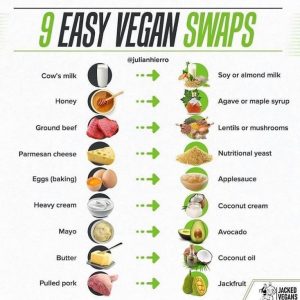
Read the labels
And lastly, animal products could be anywhere.
The following are examples of products that people might think are vegan but can be hiding animal products:
- Gummy bears (might contain non-vegan gelatin)
- Some chips (might contain milk ingredients)
- Honey (not considered vegan due to the exploitation of bees in its production)
- Red food dye (could contain carmine from crushed beetles)
Educating yourself about these things puts you in a better position to transition into veganism.
With that said, let’s move on to…
How to go vegan for beginners?
There are three ways you can transition to veganism.
By going vegan overnight
Not everyone can switch to a vegan diet overnight.
However, if you’re experiencing health issues due to the consumption of animal products, quitting cold turkey might yield positive results sooner than taking the slow, methodical approach.
Some can quit eating animal products overnight and have no issues. On the other hand, others might experience a bit of shock and feel dizzy, tired, cranky, and bloated if they’re not used to eating so much fiber, which comes with following a plant-based diet.
By going the slow route
Taking a slow, deliberate approach is the most recommended transition in order to give your body time to adjust to the new diet and prepare you to give up your favorite animal-derived foods and live a new lifestyle.
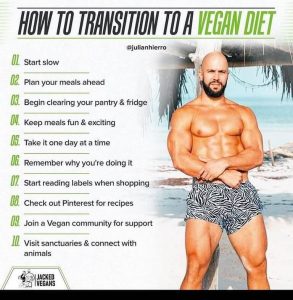
Transitioning to veganism requires a considerable change in preparing your food, what ingredients to buy, where you shop, and proper meal planning. This is the time to experiment, make mistakes and adjustments as you go along.
Start your transition slowly by doing the following:
Adding more plant-based food to your menu
Try new vegan foods, pick your favorite plant-based meals, eat them often, and rotate while building or adding more.
In the beginning, you’re probably not going to have a lot to choose from. Your food might taste bland or boring, and you might not even get all the vitamins and nutrients you need. But as you become more experienced, you’ll be able to add more to the menu. Doing this helps you to…
Cut down meat consumption
Now that you have more food options to eat, you can gradually cut down your meat consumption and replace them with some of the plant-based food options you have. You can start by cutting out the foods you didn’t like anyway since they are the easiest to remove.
If you used to eat animal products for breakfast, lunch, and dinner, you could substitute your favorite vegan meals for one or two of them. (e.g., vegan waffles instead of regular waffles, Beyond burger instead of a traditional burger, etc.).
Transition to a vegetarian first
If you love eggs and dairy products and find it hard to let go of these foods, perhaps you might convert to a vegetarian diet first. Certain vegetarians don’t eat meat but consume eggs, milk, cheese, and other dairy products.
You can leave the most challenging foods to eliminate for last so you can plan and try suitable alternatives for them.
By going plant-based for a while
Going vegan for a period of time is sort of like a “trial period” where you go vegan to see if this lifestyle is for you.
You can choose to do any of the following:
- Eat plant-based food at home: Eat vegan foods only when you are at home. You can also choose to make meals that you can take out and bring to work or school.
- Eat plant-based food before 6 pm: Eat only vegan foods before 6 pm, and eat the food of your choice, vegan or not, after 6 pm. If you love cheesecake, you can still have a slice, but it will have to wait until after 6 pm.
- Eat plant-based food for a day: Choose a day or two during the week where you only eat vegan foods.
- Eat plant-based food for a week: If you’re feeling terrific about vegan days, then you might want to extend it to a week where you consume only vegan foods. And if you’re feeling good, you might want to go vegan for a month.
How to go vegan for a month?
Now you know how you’ll approach your transition, you’ve tried being vegan for a day or a week, you’ve learned a lot from the mistakes you made, you’ve loved how eating nothing but plant-based foods, makes you feel, and you are ready for more. It’s time to take it to the next level by going vegan for a more extended period!
But before you do, it’s nice to keep these tips in mind for a smoother transition to veganism:
- Stock up on healthy foods: Make a list before heading to the grocery to make sure you buy all the ingredients, spices and flavorings that you need so you can get them all in one trip.
Here’s a sample grocery list you can take with you for guidance:
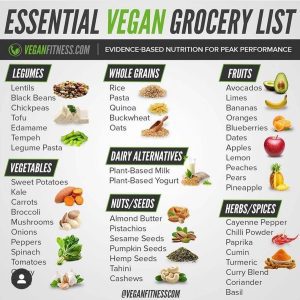
2. Watch your protein: Eating enough protein will keep you full longer and help you build muscles and burn more calories.
If you think it’s hard to meet your daily protein requirement as a vegan, think again! We have a post dedicated to educating people on the best plant-based protein sources, so you don’t have to worry about where you will get your protein next.
3. Have a go-to meal that’s easy to make, delicious, and readily available: Having something ready, or at least something you can make in 15 minutes or less, ensures you have something to eat when hunger strikes rather than reaching for a non-vegan meal.
4. Know your restaurants – It pays to know which restaurants to go to that offer vegan alternatives when you eat out. You can use Google Maps or apps such as Happy Cow to find vegan restaurants near you.
You can also use Instagram to find vegan restaurants in the city you’re living in. Type #veganrestaurants+city name (e.g., #veganrestaurantslondon) to see pictures of vegan meals and people providing feedback on the restaurants they visited.
If you can’t find a vegan restaurant, maybe you can find one that can offer vegan alternatives. You can call a restaurant in advance and ask if they can replace animal products with plant-based ingredients instead.
5. Don’t forget about supplements – Ideally, you want to consume a diverse amount of food to get the vitamins and minerals you need as a vegan, but even that might not be enough. Consume foods fortified with Vitamin D, calcium, iron, iodine, zinc, omega-3, and Vitamin B12.
You can also take supplements to add to an already healthy diet. Here are some of the best vitamins to supplement your vegan diet.
6. Treat yourself – And by that, I mean to give in to your cravings once in a while (by consuming vegan alternatives, of course).
If you’re craving ice cream, cookies, burgers, desserts, or pizza, there are plenty of alternatives out there. Just take it easy on processed food and reserve them for “reward” days to satisfy your cravings.
7. Join a community (Like the Jacked Vegan Community). Lastly, a community of like-minded people, people who have been through the transition phase, will go a long way in helping you navigate the challenges you’ll encounter along the way.
Their experience, insights, and advice (maybe even their recipes) will be valuable in helping you stay vegan.
Transition to vegan meal plan
Here’s a sample meal plan you can try. Try to mix and match, and aim for something that will give you around 2,000 calories per day.
| Breakfast | Lunch | Snack | Dinner | |
| Monday | Vegan pancakes topped with blueberries and agave | Quinoa wrap | Smoothie | Vegan burrito |
| Tuesday | Vegan waffles topped with banana and sprinkled with cinnamon | Quinoa wrap | Fresh fruits | Vegan burrito |
| Wednesday | Tofu breakfast tacos | Vegan sandwich | Fresh fruits | Vegan kebab |
| Thursday | Scrambled tofu with vegetables and beans | Tempeh Stir-fry | Seedy hummus toast | Vegan Spaghetti |
| Friday | Oatmeal bowl with fresh berries | Tempeh Stir-fry | Choco smoothie | Vegan Tacos |
| Saturday | Vegan pancakes topped with blueberries and agave | Rice and beans | Apple and peanut butter | Beyond Burger |
| Sunday | Fancy waffles topped with banana and sprinkled with cinnamon | Vegan sandwich | Celery and peanut butter | Quinoa Bean Burger |
BBC Good Food has a bunch of free vegan recipes to choose from if you’re looking to add to your menu.
Pick out your favorite foods. For some, it’s easier to eat the same foods over and over if they like them. Make your meals delicious, flavorful, and fun!
FAQs
- What’s the best way to transition to vegan? The best way to transition is the one that works for you. Like what we discussed a while ago, some people can change their diet overnight while others take longer.
If you’re the type who’s emotionally attached to some non-vegan foods and would have a more challenging time giving them up, then a slow approach would probably be best for you.
- How can I transition to vegan in 30 days? Similar to what I mentioned above, it could take sooner or longer than 30 days to transition to veganism, depending on the individual. You should do your research, try being vegan for a few days and figure out if this is a lifestyle you want.
- How long does it take to get used to being vegan? It varies significantly from one person to another.
If you’re wondering how long it takes for your taste buds to get used to a vegan diet, then it might take two to three weeks.
According to this article from The Beet, if you have certain medical conditions caused by animal products, transitioning to a vegan diet might help you experience the health benefits right away.
- Does transitioning to vegan have side effects? Some experience headaches, upset stomachs, and energy fluctuations. People react differently, and the length of time it takes to adjust to the new diet varies.
Stick to your diet until your body adjusts; however, consult a professional if you feel something is not right.
- How do I deal with family and friends when I go vegan? It’s more challenging to transition to a vegan diet when you live with others who don’t share your lifestyle.
Just be honest with them and tell them the reason you’re going vegan. Remember, these people love you, so they support what you want to do in life 99% of the time. After that, figure out how you can develop a new routine together with them.
Being vegan is more than just food; it’s a lifestyle
Now that you have the information you need to transition to veganism, it’s time to take action.
Decide whether you’ll take the overnight vegan approach, the slow approach, or if you’ll be vegan for short periods in the meantime.
Gradually add more vegan foods to your diet. Experiment with your food and make your meals tasty. Test different vegan alternatives.
Watch videos/documentaries about food production that will inspire and educate you.
And most importantly, remember the reason for switching to veganism. Aside from the health benefits, converting to veganism helps save millions of animals from cruelty and helps lessen the carbon footprint on the planet. Each effort counts!
Good luck, and have fun on your vegan journey!

